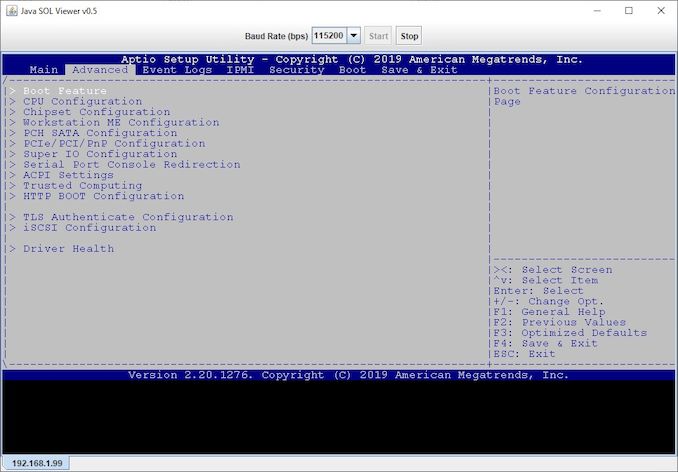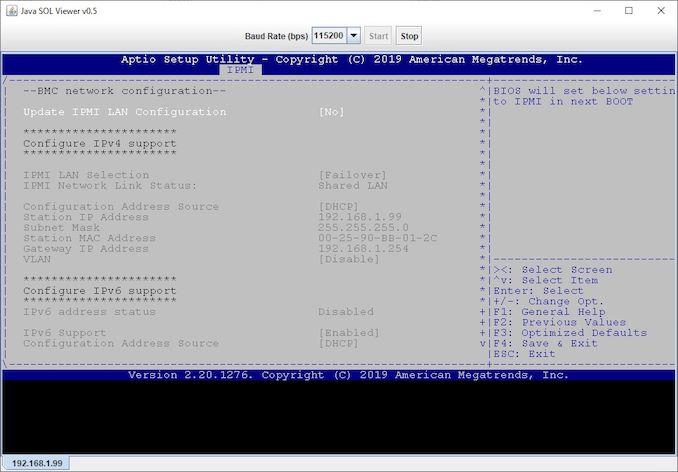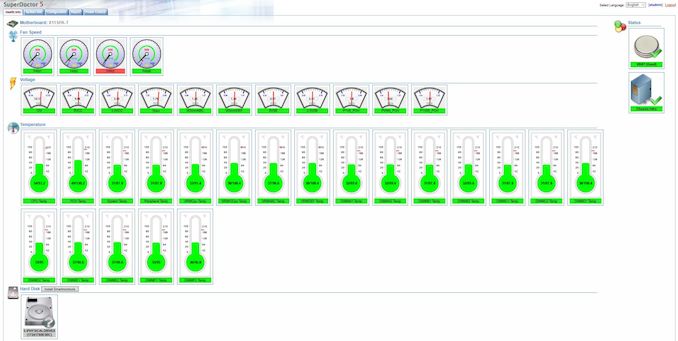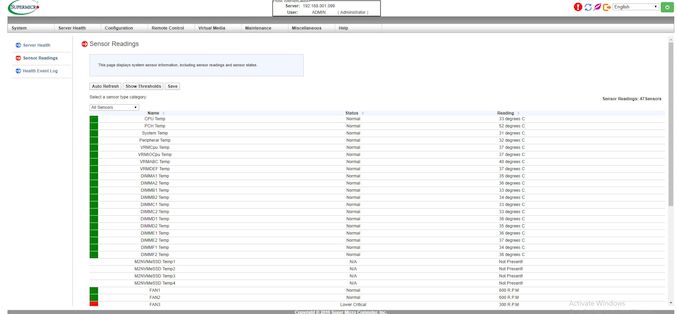The Supermicro X11SPA-T Review: An Impressive Cascade Lake Workstation Motherboard
by Gavin Bonshor on January 24, 2020 9:00 AM ESTBIOS
The Supermicro X11SPA-T is using a basic version of its UEFI BIOS, which is designed with function in mind and not aesthetics. The firmware GUI consists of a white background with black text, and blue highlights. Due to the firmware's archaic design, there is no screenshot capture hotkey. Instead, to pull images of the firmware, we had to connect to the system via the ASPEED AST2500 BMC controller and screenshot the screen from Java's SQL Viewer.
We updated the Supermicro X11SPA-T to the latest firmware, BIOS version 3.2, and to flash it we used the DOS command structure via the built-in EFI shell. Users can update the firmware through connection to the BMC as an alternative to DOS.
As with older style motherboard firmware, all of the menus are located along the top with primary menus including the main screen (as above), an advanced section, event logs, IPMI settings, security, boot, and the usual save & exit settings. The Supermicro X11SPA-T does not support overclocking of any kind, not even memory tuning which is common for a prosumer workstation focused model such as this one.
Under the advanced tab, users can customize multiple aspects of the system with the boot feature menu allowing users to enable or disable Windows 7 USB installation support. Other options include CPU power settings including the enabling and disabling of Multithreading, how many CPU cores are enabled, and settings such as Virtualization technology for running virtual machines. Users can also alter the configuration of the PCIe 3.0 slots with MMIO settings also present.
One of the key functions of the Supermicro X11SPA-T is that it allows users to connect remotely to the system via the Realtek8211E PHY on the rear panel. Within the firmware, users can view the status of the network including the IP address which is required to log in remotely from another system.
The Supermicro X11SPA-T motherboard is designed for professional use and omits the fancy GUI of desktop-based models. All of the core features from a workstation-based model are present including OS support, remote connectivity, and Supermicro does it without much fanfare. It's a conventional BIOS for a conventional workstation platform such as C621.
Software
Any form of software and driver installation media is excluded from the accessories bundle, but users can download a full disc image directly from the official product page on the Supermicro website. Aside from the drivers for key functions for the ASPEED BMC controller, audio drivers, and core Intel drivers, the only utility available is Supermicro's SuperDoctor 5 software.
The SuperDoctor 5 utility allows users to monitor hardware and integrated sensors remotely, as well within the system. It offers plenty of network management options including alerts, allows users to perform system resets and shutdowns, including firmware updates. This offers an alternative to the remote functionality of the BMC and offers a more friendly GUI. Similar to a 'Command Center' from other manufacturers, it allows real-time view of storage health, fan speed, temperatures etc.
Another alternative to connecting to the system via the static IP address. This provides a similar function to SuperDoctor 5, including monitoring, setting alerts, and checking system information. Users can also perform system maintenance and view the system in real-time through Java including the firmware. Other settings that can be customized include the date and time, IP Access Control, configuring the fans settings, as well as allowing users to upload SSL certificates.



























31 Comments
View All Comments
Hackerman12345fgn - Tuesday, January 28, 2020 - link
<i>XD</i>